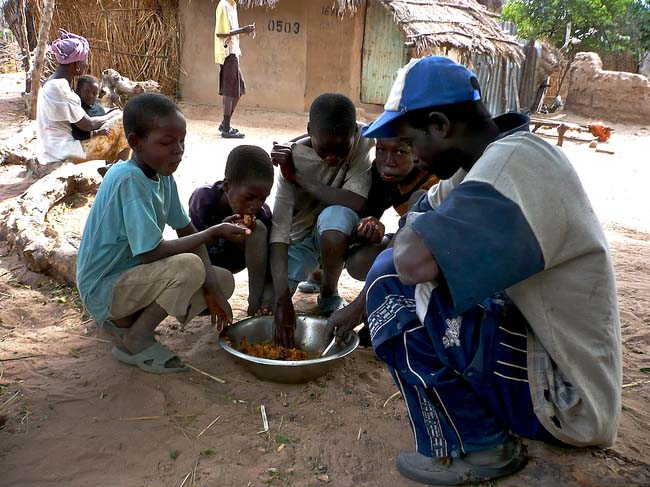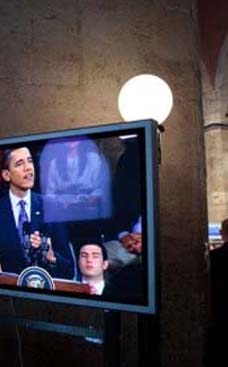
Yero’s family starts to guide him out to the sandy road and back to his compound, his stunted steps sinking beneath him. Amadou looks down at his trees and then at his friend Njie, who is standing beside him. Njie watches in disappointment as Yero slowly scuffs away. He knows the potential in Amadou’s trees and he knows the danger of resisting change. In a hushed voice he leans close to me. “A little bit of knowledge is a dangerous thing.” Six months later, Amadou stands on an empty oil drum in a peanut field planted with Winter Thorn saplings. He throws handfuls of peanuts, twigs, and leaves high into the air, allowing the breeze to sort the harvest. The heavy peanuts fall to the earth, while the leaves and twigs blow away. The saplings have started to take root. “Watch out,” I say with a smile. “You’ll bury the trees with all those leaves and twigs, and we’ll never find them again.”
The Gambia Peace Corps Volunteer Brian Carroll writes: It Takes A Thorn Tree To Raise A Child
It Takes A Thorn Tree To Raise A Child
by Brian Carroll
5 May 2009
Caption: I squat in front of the giant stainless steel bowl and struggle to squeeze into the open space. Keeping our balance is difficult—one ill-timed twitch, one spasm, and we might all end up on our backs. Photo by Brian Carroll.
I squat in front of the giant stainless steel bowl and struggle to squeeze into the open space. There are 10 of us sharing lunch together, wrapped inside billowing kaftan robes. Our elbows knock each other as we reach for handfuls of benachin (a mixture of oily rice, sweet potato, cassava, and a trace of meat). Keeping our balance is difficult—one ill-timed twitch, one spasm, and we might all end up on our backs. In The Gambia, this is how we celebrate the naming of a new child. Today, it is my host father Amadou’s new son, Abdoulie.
The food vanishes in minutes, bringing the ceremony to an end. Everyone scatters to the shade of mud walls and mango trees, seeking respite from the relentless sun. I glance toward the entrance to Amadou's grassy compound, and I see them: Winter Thorn trees, 200 seedlings in black plastic pots. As part of my work with the Peace Corps, I will spend the next few weeks helping Amadou plant these trees throughout his peanut and millet fields. They are small, but their potential is enormous. And in a village where farming hasn't progressed much in the last few thousand years, they represent an important opportunity to embrace change.
The Winter Thorn is a natural and sustainable means of fertilization. Its roots fix nitrogen deep in the soil, while leaving the top layers undisturbed so that crops can be planted. The trees lose their leaves during the growing season, thereby adding more nutrients to the soil, while at the same time not competing with crops for sunlight. The leaves, shoots, and seedpods also attract foraging animals, and these animals leave behind manure, which further enriches the soil. It’s a perfect cycle—a simple solution in a seed.
But there are some who resist the Winter Thorn.
Amadou is standing at the gate, saying goodbye to Yero Ketta, one of the village elders. The old man looks at the Winter Thorns, and asks what they are for.
“For the fields,” Amadou answers, half distracted by another group of guests. “We’ll plant them to fertilize the fields.” Yero pauses for a moment, his small, thin frame hunched beside an upright gatepost. His eyes are wide and fierce.
“Not this tree,” he says, glaring. “You don’t want this tree. It will only fill your fields with birds and thorns.” The creases on Yero Ketta’s face look like dry riverbeds—dusty and permanent—and the bristled white hairs on his chin stand on end. Amadou listens patiently, still wrapped in his spotless white robe from the day’s celebration.
“Yes. You are right, you are right,” he says out of respect. “But we will try them. Maybe we will see a benefit.”
Yero turns to a group of guests who have gathered at the gate and points a thin finger at the saplings as if to damn them. “You’ll ruin your crops! The birds will destroy them!”
Yero’s family starts to guide him out to the sandy road and back to his compound, his stunted steps sinking beneath him. Amadou looks down at his trees and then at his friend Njie, who is standing beside him. Njie watches in disappointment as Yero slowly scuffs away. He knows the potential in Amadou’s trees and he knows the danger of resisting change. In a hushed voice he leans close to me.
“A little bit of knowledge is a dangerous thing.”
Six months later, Amadou stands on an empty oil drum in a peanut field planted with Winter Thorn saplings. He throws handfuls of peanuts, twigs, and leaves high into the air, allowing the breeze to sort the harvest. The heavy peanuts fall to the earth, while the leaves and twigs blow away. The saplings have started to take root.
“Watch out,” I say with a smile. “You’ll bury the trees with all those leaves and twigs, and we’ll never find them again.”
Amadou laughs and takes a basket of peanuts out of my hands. “They’re strong trees,” he says. “They’ll find us.”
We pour the peanuts into empty rice bags and load them onto a cart. I wince as one of the cart’s wheels crushes a tiny sapling, but a moment later, it springs back up. I smile. Survival is tough in the dusty upcountry, but these trees have what it takes to thrive. Fortunately, Amadou’s village affords elders like Yero Ketta respect, but does not rely on them to make important farming decisions.
Sitting with Amadou and Abdoulie, now six months old, under the shade of a mango tree, I wait for glowing coals to boil a sugary green tea called attaya. Abdoulie throws his head back to see his father’s face and flashes a rapt smile. His hand reaches out, searching the air for a single, calloused finger.
Amadou pours a tiny glass of tea and hands it to me, as Abdoulie watches intently. Amadou pours a second glass and we drink together. The tea is so dark that the glass is almost completely black, and so hot that I nearly burn my tongue. Abdoulie mumbles to his father in gibberish, and Amadou mumbles back.
Abdoulie and the Winter Thorns came into Amadou’s life in the same week, and they will literally grow up together. Together, they represent the test of a father’s ideas—the test of a changing relationship between farmer and field. Their success can prove a village’s ability to adapt to the changing world around them.
Abdoulie mumbles again, and reaches for his father’s cup. I laugh at the exchange. “He’s waiting for his tea, Amadou.”











